Magnus was a beekeeper in his youth in western Sweden. He quit in 1996 but started again in 2013 with his wife Ulrika. Then they bought from an older beekeepers a pavilion with seven bee colonies, most of which were splits, new colonies.
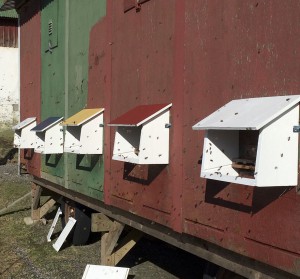 It was a big pavilion on wheels that they bought.
It was a big pavilion on wheels that they bought.
It was not crowded with bees where this beekeeper lived from whom they bought the bees. Maybe a couple of miles (3 km) to other bees than his. He treated with oxalic acid against Varroa once a year. Nothing more was used for keeping the Varroa population down. And he bought a Buckfast queen now and then to help the genetic variation.
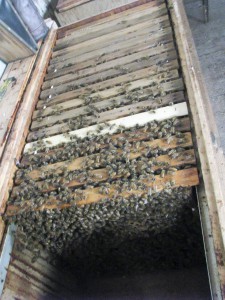 The hives in the pavilion are long hives with 30 combs 12″x12″ (30 x 30 cm).
The hives in the pavilion are long hives with 30 combs 12″x12″ (30 x 30 cm).
The pavilion was moved to Magnus and Ulrika in September. They saw wingless bees from three colonies. Two of these were splits from the third. Of the other four were at least two splits from one of the rest, No. 9. The fourth, No. 10, appeared to be related to No. 9, because of the behavior and appearance. Maybe No. 9 was a split from No. 10 in 2012. The argument for this is that in 2014 the queen just fell of the combs in No 10 and died. Perhaps the queen was the oldest of the two.
Magnus and Ulrika has their bees quite isolated too (about 3 km) in relation to other bees. In October 2013 they treated all seven colonies with oxalic acid. From the three with wingless bees fell very many mites due to the treatment. From the other four just about 10 mites from each. These four were also the only one to survive the winter.
Low level start in 2014
In August 2014 they treated all colonies with thymol. Now they were ten. Magnus and Ulrika wanted to bring all colonies into a low level situation concerning mites as a start for the coming years. The next year they planned to check the infestation level of mites with the bee shaker bootle and treat only those with an infestation level of at least 3% in August.
They probably did too many splits, as some were a bit weak in autumn. No. 10 was still there, but with a new Buckfast queen from a queen breeder. No split had a daughter of No. 9 or No. 10 as its queen. Only No. 9 had its original queen.
No colony had been purchased and brought into their area from “outside”. All new colonies were splits from the first four who survived the first winter with Magnus and Ulrika.
The mites that fell after thymol treatment were about as many as the previous year after the oxalic acid treatment, that is very few.
Seven survived the winter. Three splits were obviously too small and did not make it.
Bee shaker 2015
In autumn 2015, they wintered 13 colonies. They controlled the infestation rate in August with the help of the bee shaker (http://www.elgon.es/diary/?p=794), ie alcohol sample of 300 bees. Only the “old” colonies were tested. Magnus and Ulrika did not want to weaken the splits made in 2015. Two of these were a bit weak in the autumn due to queen problems. If an “old” colony had more than 3% infestation rate (9 mites from 300 bees) also the splits made from it would be treated was the strategy.
Those which had higher infestation rate than 3% in August were treated with thymol. There were three colonies that had just over 3%. Only those three which no splits had been taken from. Some of the other “old” colonies had only one mite from 300 bees, i.e. 0.3% infestation level. All the others except the three were not treated.
Ten colonies survived to 2016. Two of the three dead were the weak due queen problems in the autumn. The third died of local starvation. There were some empty frames between food combs and the bee cluster.
No colony during the last two winters have died because of large levels of Varroa. Varroa is evidently not a problem. Varroa levels have always been low in these colonies that originated from bees from the No. 9 and No. 10, also in 2013.
The colonies from the No. 9 and No. 10th
What naturally would come to mind is that we have found a tiny varroa resistant local bee stock genetically, if the queens are all descended from the No. 9 and No. 10. But that is not the case! Several of the daughter colonies had received queen pupae from a queen breeder. Some had been laying queens from the same breeder. He doesn’t select for varroa resistance and use effective miticides. Still, even colonies with these queens have very small levels of varroa. But the worker bees that these queens were introduced into came directly or “indirectly” from No. 9 or No. 10. Some splits from No. 9 were made in 2015. The other “mother colonies” were splits made in 2014 from No. 9, though with queens from a Buckfast queen breeder. These colonies are not ffsprings genetically, “only” “social offsprings” through the worker bees. The colony No. 10, is the social offspring of the original No. 10. Eight colonies are social offsprings of No. 9. No. 9 have the original queen. Only No. 9 have a “true” varroa resistant genetic set up.
Naturrum 2016
The first weekend in April 2016, I had a lecture at the Visitor Centre at Getteron at the west coast of Sweden close to the little town Varberg. I talked about breeding bees resistant to varroa. In the afternoon there were some workshops. One on how to check the infestation level of Varroa with the Bee shaker. The other how to make dish cloth pieces with thymol to treat against Varroa.
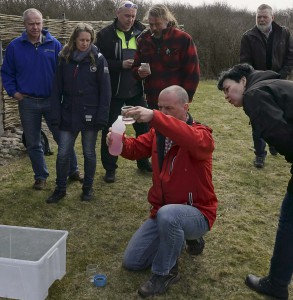 Magnus and Ulrika pouring alcohol in the Bee shaker. Somewhat more.
Magnus and Ulrika pouring alcohol in the Bee shaker. Somewhat more.
Magnus had brought a colony that hadn’t been treated against varroa the previous year. The queen was an introduced egg-laying Buckfast queen from a queen breeder. A queen which was not selected for varroa resistance. We hoped it would be a substantial amount of varroa in the colony so there would be some to count at the bottom of the Bee shaker.
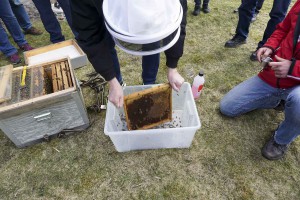 The fourth comb from the rear with a lot of bees on it but no brood, to minimize the risk of including the queen.
The fourth comb from the rear with a lot of bees on it but no brood, to minimize the risk of including the queen.
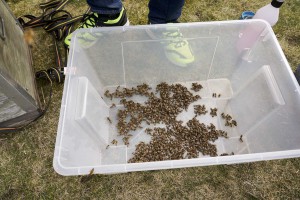 The bees were shaken into a corner. With a measuring cup a little more than 1 dl bees were talken and poured into one half of the Bee shaker.
The bees were shaken into a corner. With a measuring cup a little more than 1 dl bees were talken and poured into one half of the Bee shaker.
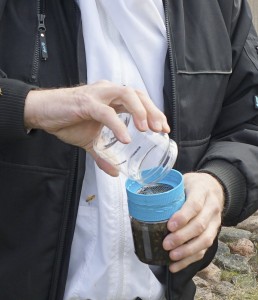 After the bees had been poured into one half of the Bee shaker the lids were screwed on top. Then the alcohol was poured on the bees from the other half. This half was then screwed to the rest. Now the Bee shaker was shaken for one minute. Turned around, still shaken until all the alcohol had went down in the lower part.
After the bees had been poured into one half of the Bee shaker the lids were screwed on top. Then the alcohol was poured on the bees from the other half. This half was then screwed to the rest. Now the Bee shaker was shaken for one minute. Turned around, still shaken until all the alcohol had went down in the lower part.
Too few mites
In August 2015 it was one mite in 300 bees in that test colony at the workshop. Now April 2 the colony was a strong and healthy colony of bees filling the box that had been the winter room. The bees were very calm and sampling went well. I lifted the fourth comb from the rear, with no brood, but close to the brood. To our “disappointment” it showed only one mite in 300 bees. One can truly say that we were surprised.
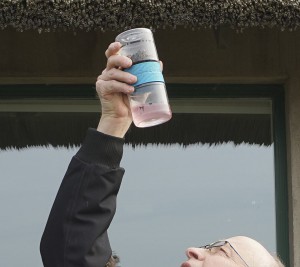 When all the alcohol had went down, the Bee shaker was lifted above the head and the mites were counted on the bottom of the Bee shaker.
When all the alcohol had went down, the Bee shaker was lifted above the head and the mites were counted on the bottom of the Bee shaker.
How could this colony be varroa resistant? And No. 9? And the colonies that were made with bees from No. 9 but with no daughter queen from No. 9. All Magnus’ and Ulrika’s current colonies and their social offsprings have demonstrated surprisingly low amounts of mites all of the years with them. Although their queens are not genetically related to the original resistant colonies. They are though social offspring, as described above what that means.
The explanation
I had in my lecture talked about the experience of Hans-Otto Johnsen and Terje Reinertsen in Norway that can hardly be explained otherwise than that worker bees in resistant colonies teach other bees how to control mites.
Sampling with the Bee shaker on Getteron confirmed what I had lectured in a most interesting way.
Look for resistant bees
Now is the time for beekeepers that have had varroa in their colonies for a few years and have not yet checked the downfall of mites after treating. Check the differences of downfalls between different colonies. Especially you can discover good colonies in apiaries located somewhat isolated and in which there are not so many bee colonies. This lessen the risk for reinvasion of mites in the colonies. It’s good if the apiary have somewhat developed a stock of its own, ie no colonies or packages have been brought into the apiary in recent years and mostly queens have been bred from colonies in the apiary.
I’m sure there are many resistant colonies to be found today, but you must look for them.
You should make splits from the best ones.
The poorest colonies should not be used to make splits from, in any case you should avoid it.
You can buy Bee shakers here: http://www.elgon.es/diary/?p=809
Resistant genes are important but resistant worker bees are more important
Of course, it requires a certain amount of resistant genes for a colony of bees to be able to develop resistance and be able to teach other worker bees how to control mites. When there are colonies which have developed good resistance it seems less genetic resistance quality is required to be able to be taught ability to control mites than to initially develop and learn this property.
If you find resistant colonies
If you find resistant colonies, even if they are somewhat bad tempered, swarmy, and only give small crops of honey, take care of them like golden nuggets. Move them if you can to an apiary of their own somewhat isolated, a couple of miles (3 km) to the other bees. Make splits from them and give those splits pupae bred from good tempered bees, reluctant to swarm and high producing.. Then continue to do splits following year from the best varroa resistant colonies and let them make their own queens. Doing so also from the original resistant colonies and let them make their own queens. Now there are good drones in respect to other good qualities from the previous year’s new colonies. Continue the following years to replace the poorest queens with those bred from the best in the apiary.
Interesting report, it highlights the epigenetic or “socially transfer” role of resistant behaviour.
Can this information back uped with other measures like the amount of hygienice behaviour, establishment of drone brood etc. ? It would be nice to know, what kind of resistant behaviour is teached by the experienced bees. IS it always hygienic behaviour, or the ability to select the right drones during mating or the ability to draw drone cells?
What one can do is to make splits from good resistant colonies and then variate the amount of “experienced worker bees” in relation to the other bees and then check, what is the minimum amount of experienced workers that is needed…
And I completely agree with your conclusion, that one should keep all eyes open to detect the nuggets among own hives in terms of resistance behaviour.
How used brother Adam to say: “Jegliche Heilmittelbehandlung hat den Nachteil, das ihre Wirkung von vorübergehender Dauer ist. Mit anderen Worten: Sobald man zu HEilmitteln greift, bedingt deren Gebrauch ständige Anwendung.”
In english: Every treatment has the disadvantage, that the their effect is temporary. With other words: If one uses treatment one has to face their continous application.
Looking at the situation nowadays one has to add: “One has to face continous application with increasing doses over time.”
Experiences from Norway points to grooming as an important part of the learning factor in resistance. As the bees after picking up many mites through reinvasion show an highly increased downfall of mites. Often this reinvasion occurs at the end of the season. And this downfall has been going on closely before winter starts until it stops completely. When an alcohol test is done the infestation level is zero or close to zero.
When it comes to this Swedish experience, when these first resistant colonies were discovered in the pavilion, there were almost as many colonies very close to them with high numbers of mites, seemingly without the resistant ones getting reinvaded as the mites falling were very low. This can be explained by two things. The bees stopped bees with mites from entering the hive. Or/and they very quickly removed them from fellow bees and mutilated them.
I don’t think we can rule out different acts of hygienic behaviour to have learned parts either.
OK you point to grooming…. I spoke with Wallner the austian guy, who is breeding for grooming 2 years ago, whether grooming alone is a sufficient trait for mite resistance. He said, that grooming alone is not enough. All his survivor colonies have significant amounts of hyg. behaviour as well.
If it is only grooming, than the bees must be heavily fast by preventing the mites from entering brood cells…
But maybe combined with hive guarding, not allowing infested bees into the hive, as you pointed out….
I think there is another possible explanation. Maybe the mites are less virulent? As is discovered in the Gotland experiment by Löcke and Fries…
Thanks for comment. I like comments, they keep your brain alert. And many good thoughts.
Concerning differences in virulens of mites Tests of Fries has shown there is no difference in virulens of mites on mainland Sweden and on island Gotland.
Another thing in this case is that in 2013, 3 colonies in the pavilion had very high levels of mites, and DW-virus. While the four of this particular kind, the resistant ones, had very few mites, though very close to the others. The same type of mites as they were so close, and as some have suggested less virulent virus, is of no concern as the number of mites was very low. The most probable explanation as I can see is that the worker bees taught other worker bees how to control mites. Which means it’s very important to make new colonies from these good colonies, and to actually get rid of the bad colonies. or maybe combine the bad ones with some kind of number of bees from the good ones. Maybe that’s possible.
Maybe. I don’t agree with you on “no difference in virulence of mites”. For instance, the study “Host adaptations reduce the reproductive success of Varroa destructor in two distinct European honey bee populations. (Barbara Locke, Yves Le Conte, Didier Crauser and Ingemar Fries)” clearly states in the abstract: “Our study shows that two of these “natural” honey bee populations, in Avignon, France and Gotland, Sweden, have in fact evolved resistant traits that reduce the fitness of the mite (measured as the reproductive success), thereby reducing the parasitic load within the colony to evade the development of overt viral infections. Mite reproductive success was reduced by about 30% in both populations. Detailed examinations of mite reproductive parameters suggest these geographically and genetically distinct populations favor different mechanisms of resistance, even though they have experienced similar selection pressures of mite infestation. Compared to unrelated control colonies in the same location, mites in the Avignon population had high levels of infertility while in Gotland there was a higher proportions of mites that delayed initiation of egg-laying. Possible explanations for the observed rapid coevolution are discussed.”
I understand your point about necessity of actively selecting your bees, in stead of counting on the selection of scientific institutes and commercial queen breeders. But in general I regret the lack of attention in the beekeepers world for the fact that it is easier and faster to select for a less virulent mite than to select for a more hygienic bee. Bees get a new generation each year, while the mites have a new generation every few weeks…
Thanks for keeping this interesting blog. Ity keeps my mind fresh too…
The key quote from your quote is the following:
“Our study shows that two of these ‘natural’ honey bee populations, in Avignon, France and Gotland, Sweden, have in fact evolved resistant traits that reduce the fitness of the mite…”
This study actually confirma the earlier study that checked the mainland Sweden and the island (Gotland) Sweden mite population and their virulence (no difference), by Fries.
It was the bee populations that evolved, not the mite populations, according to the scientists here.
Luc,
I found the article by Fries and Bommarco for download here, with the result of no difference of virulence between different strains of mites.
https://hal.archives-ouvertes.fr/hal-00892291/document
“The results showed that the overall mite population growth rate was
reduced by 82% in Bond colonies compared to Control colonies, irrespective of the mite source (mites from
Bond or Control colonies).”
Hi!
I bought 4 Colonies small cell bees 2015 and made 4 splits out of 3.
3 are AMM and mutts, 5 are Carnica and mutts.
The”races” are in different bee yards.
All are not treated for some years, 4 years I know of.
All survived winter.
I have not taken any honey out, but the former owner had. So the bees had sugar syrup and honey in fall.
I have not seen the defect wing virus so far.
I keep distance between the hives to prevent drifting. That I did because I want to select the best hives. But I will follow your advise to split for 3 years to have enough hives to select from.
Now my question:
One colony of the Carnis has the Paralyse Virus. This one I bought later in summer to improve the genetic diversity. A mistake? It`s not resistant, it seems.
Should I change the queen if they survive?
They just now supersede her.
If they survive with the new queen is it resistant stock?
This Virus is not always the result of varroa infestation I read.
I did one management, I tossed all bees down into the grass so the sick ones could not fly back. There are less sick bees now in the hive but still some.
Is it an advantage now to have the other ones in a distance? 50m.
If I read above it could be an advantage to have no distance between colonies and let them drift to learn resistance.
If sickness is in your bee yard it`s good to have this colony isolated.
If good behavior is needed like varroa grooming it`s not wished.
I´m a beginner. Can you give me some advise how to arrange my apiary?
I will get a colony from a friend this year who has some Elgons from you and those bees will have Elgon and Carnica genes.
Hope to improve the genetics but I don`t want to jeopardize this hive.
Thanks, Sibylle
Hi Sibylle
Glad you have survivors that have been without treatment for so manµ years. I think you have done the right thing and helped the bees to get rid of the virusfilled bees. Those are of course the result of too many mites. So that the bees shift their queen is a response in their process of adapting to deal with the mites.
One option is to remove the affected colony to a colony of its own and abandon it eventually. Instead splitting your resistant colonies.
Another option is to to give the sick colony two frames of brood AND bees from a resistant colony. Early in the season you normally can do that without them fighting. But the field bees will return to their old hive and it’s the older bees, not the newly born you want in your sick colony to teach them how to control the mites.
A third option is to do both above, but them move the colony at least 3 km to keep the field bees.
A fourth option is to shift place between the sick colony and a healthy. That will cure them I think.
Don’t bring in too many colonies from outside at the same time, just one or a few. You resistant colonies I think must be in dominance.
Hi Erik
great advise.
Tomorrow I will do the management again if they are still strong enough.
Then see what happens with the new queen and after brood pause.
If they are weak, I could give them one or two brood combs of my strongest colony, maybe with queen cells, if those have them, and destroy their own queen cells.
Even though I am curious about them healing themselves with their own queen and will give them brood comb for strength of bee number eventually.
Maybe shifting places will be my second option. Good idea.
Nice to learn things.
Sibylle
Hi Erik!
The sick colony is healthy again, no more trembling bees, superseding in progress.
Before shifting place I have questions:
The Paralyse Virus is spread by mouth to mouth feeding.
The new queen was maybe given geleé royale by virus filled bees.
How to cope with this?
Will she be immune or sick?
Will they supersede again?
Shall I wait how healthy the new brood will be before shifting?
As I understand you shifting will be to teach the worker bees to handle varroa.
Shifting to fight the virus is not possible I think. Am I right or wrong?
Sorry, I´m not a scientist.
Thanks,
Sibylle
Superseding in progress. I assume then that the colony has no open brood, not so much capped and a virgin queen that is going to be mated? If so you have to wait to shift place between this colony and another until the new queens is laying. Otherwise she woun’t find her way back to right colony after a mating flight. A big risk anyway.
How the virus is spread may well be as you say. The bees fight, we don’t always know how. You have to do what you can anyway to help them the best you can. A broodless period is good, which happens during superseding.
Shift place of colonies, if that’s what you plan, when the new queen is laying and have open brood soon to be capped, or the first capped brood. The new queen is somewhat more mature and move a little slower and will cope better towards the new field bees so they will accept each other.
How much the field bees will learn the colony I don’t know. Maybe some virus fighting abilities too, who knows, like throwing out virusfilled young bees. Another virus defense is producing peptides of the right sort. I suppose this has to do more with genetics, possibly some epigenetic adaptation as well.
Ok.
Thanks a lot.
Sibylle